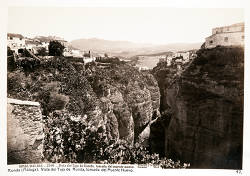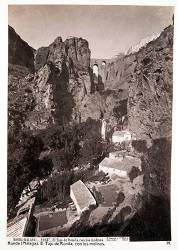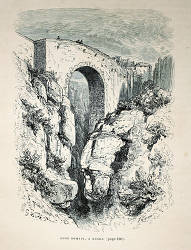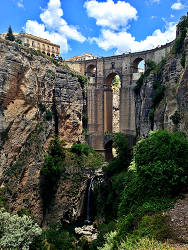El Tajo Canyon
El Tajo de Ronda
Useful Information


| Location: | In the middle of Ronda. (36.74037°, -5.16448°) |
| Open: |
no restrictions. Casa del Rey Moro: OCT to APR daily 1010. MAY to SEP daily 10-21:30. [2020] |
| Fee: |
free. Casa del Rey Moro: Adults EUR 7, Children (0-11) EUR 3.50. [2020] |
| Classification: |
 Gorge Gorge
|
| Light: | n/a |
| Dimension: | L=500 m, D=100m |
| Guided tours: |
self guided.
Casa del Rey Moro: audioguides in various languages as free smartphone app |
| Photography: | allowed |
| Accessibility: | partly |
| Bibliography: | Barón Jean Charles Davillier (1874): L’Espagne, ilustrée de 309 gravures dessinées su bois par Gustave Doré. - Paris : Librairie Hachette, 1874. - 799 p. : il. |
| Address: |
Casa del Rey Moro, C/Cuesta de Santo Domingo, nº 9, 29400 - Ronda, Málaga, Tel: +34-617-61-0808.
E-mail: Oficina Municipal de Turismo, Paseo de Blas Infante s/n, 29400 - Ronda, Málaga, Tel: +34-952-187119. E-mail: |
| As far as we know this information was accurate when it was published (see years in brackets), but may have changed since then. Please check rates and details directly with the companies in question if you need more recent info. |
|
History
| 1735 | New Bridge built. |
| 1741 | New bridge collapses killing six people. |
| 1751 | new bridge reconstruction started. |
| 1793 | new bridge completed. |
| 2019 | declared Monumento Natural de Andalucía. |
Description


El Tajo Canyon, also known as Tajo de Ronda, is located in the middle of the city Ronda and formed by the Guadalevín River, a tributary of the Guadiaro river. The 100 m deep and 50 m wide gorge cuts the 35,000 inhabitant city into two parts. To connect the cities three bridges were built. Puente Romano (Roman Bridge) is also known as the Puente San Miguel. Puente Viejo (Old Bridge) is also known as Puente Árabe (Arab Bridge). Before the third bridge was built it was also named Puente Nuevo (New Bridge). And the Puente Nuevo (New Bridge), actually the newest bridge built between 1751 and 1793. It is the tallest of the bridges, towering 120 m above the canyon floor. The bridge is filming location for the 2020 Netflix series the Warrior Nun. The best view of the bridge and canyon is from El Parador de Ronda (former government owned luxury hotel) at the former town hall.
There are various possibilities to see the canyon from the town. Every bridge offers a view into the gorge, but this was not always the case. The Puente Viejo (Old Bridge) was restored several years ago, and the 17th century parapets which prevented the view into the gorge were changed. Now there are four balconies, two on each side, which allow a panoramic view into the gorge and the surroundings.
Then there is the Jardines De Cuenca o De La Mina park on the northern rim. Beneath the botanical garden there are numerous miradores (outlooks). There is also an interesting geotope called Asa de la Caldera.
And finally it is possible to walk through the gorge. The trail starts at the Puente Romano on the east side of the gorge. This is the smallest bridge and it is located at the foot of of the plateau where the southern city was built on. At the bottom of the gorge is the river and several ponds connected by mill canals. Its not possible to cross the gorge completely, there is no trail on the western end, but it is possible see this side of the gorge from the Hostel Los Molinos which is located in a historic water mill, and from various other outlooks,
The most spectacular building connected with the gorge is the well in the Casa del Rey Moro (House of the Moorish King). The house and well were erected in the 14th century, during the rule of King Abomelic. The well which goes down all the way to the river in the gorge is one of the main hydraulic engineering works built in the Nasrid Kingdom and the best preserved in Andalusia. It is called La Mina de Agua (water mine) and its purpose was to pump water from the river to supply the population of the walled city in case of a siege. Built into an existing crack in the gorge wall which was excavated in depth, steps were carved into the rock to create a descending gallery covered with vaults. The Sala de la Noria was named for the large water wheel which was used to pump water. The gallery is quite narrow, which prevented the use of animals, so it had to be operated by people. Christian slaves had to turn it by hand, others formed a human chain on the narrow staircase to hand zaques, water filled leather bags, up to the city. If there were not enough slaves they had to walk up and down carrying the zaques. At various points in the staircase are extensions where they could pass each other.
The well was an essential part of the defensive system of the city. It was built like a fortress tower and was manned by the military. The Sala de Armas (armory) contained weapons, water and oil which were heated and thrown out through arrow slits to repel attackers. Exceptional is the Sala de los Secretos (Vault of Secrets) with its circular cupola. It has an acoustic feat which was not intended: words whispered at any point along the wall of the cupola are clearly understood at any other point around the wall. It was named Vault of Secrets by visitors during the 18th century. Originally it was another well for the garrison of the tower. At the lowest part of the tower is a small secret door to the river, which served as an escape.
But all the ingenuity was not sufficient. The city was finally conquered by the Reconquista, and actually by conquering the Mina de Aqua and entering the city through this weak spot.
El Tajo Canyon even made it into world literature, it is mentioned in Hemingway’s novel For Whom the Bell Tolls. The Republicans execute Nationalists by throwing them from cliffs in an Andalusian village, which was based on actual killings that took place in Ronda at the cliffs of El Tajo.
 Search DuckDuckGo for "El Tajo Canyon"
Search DuckDuckGo for "El Tajo Canyon" Google Earth Placemark
Google Earth Placemark Tajo de Ronda
Tajo de Ronda  - Wikipedia (visited: 31-JUL-2020)
- Wikipedia (visited: 31-JUL-2020) La Casa del Rey Moro (visited: 31-JUL-2020)
La Casa del Rey Moro (visited: 31-JUL-2020) Index
Index Topics
Topics Hierarchical
Hierarchical Countries
Countries Maps
Maps